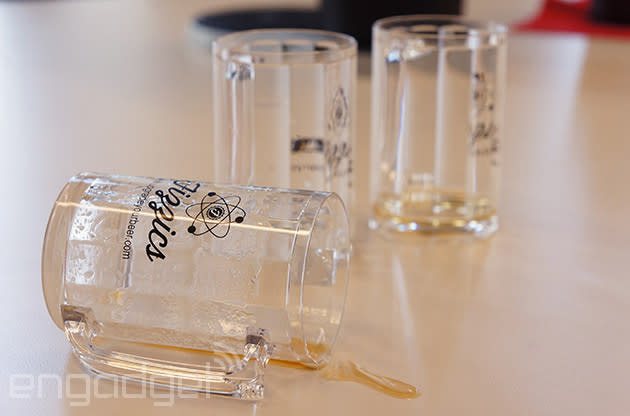Fizzics countertop 'draught' system makes bad beer good

I like -- nay -- love beer. But I'll be honest, when I first heard about Fizzics and its promise to deliver the perfect pour of tap-quality beer from any can or bottle I dismissed it. It seems like the sort of silly snake oil you'd find in SkyMall or Sharper Image. But, I gave Philip Petracca, the CEO of the company the opportunity to convince me otherwise. He swung by the Engadget compound with a cooler full of beer and a pitch full of science. I'm convinced he's not just some huckster, but whether or not Fizzics truly makes beer better is a different question.
So let's start with how this thing works. The prototype Fizzics unit Petracca demoed for us basically has three major parts: a pressurized chamber to hold the beer, a sound-wave generator for creating foam and a microcontroller. You put your can, bottle or (in the production version) your growler in the chamber, insert the tube and seal it shut. Then you pull the handle forward to "tap" your beer. The chamber pressurizes and forces the beer through the tube and into your glass in an attempt to preserve as much carbonation as possible. The real unique feature of Fizzics, however, kicks in when you press the handle backward. This triggers a sound-wave generator that breaks up the bubbles of carbon dioxide in your beer, creating a dense head of foam with roughly uniformly sized bubbles.

The point here is that the head of the beer is incredibly important. Sure, it looks nice, but more importantly it contributes to mouthfeel and aroma. Petracca says the larger, less uniform bubbles in a hand-poured beer are interpreted by your brain as being "grainy," where as the goal should be creamy. He could go on and on about how your trigeminal nerve is important to texture interpretation, or about how the esters released through creation of foam enhance aroma, or even how important LTP1 proteins derived from barley are in determining the quality of the head on a beer. But, honestly, none of this seemingly legitimate science matters if you can't taste the difference.
We had a pretty sizable menu of beers to work through: a Coors, a Brooklyn Summer Ale, a Brooklyn Brown Ale, a Sam Adams Cherry Wheat, a Southern Tier IPA and a Yuengling. Visually, it's striking how much different a beer from Fizzics is from one you poured yourself. Sure, in a small tasting glass like the ones we used, it's hard to develop a good head on a beer from a hand pour. But even taking that into account, the Fizzics produced a thicker, more uniform head that hung around a lot longer. And the bubbles clung to the side of the glass creating nice lacing. Even on something like the Coors, where the head dissipates almost instantly when poured from a can, it hung on for a solid minute.
There's no denying the effect on the mouthfeel. All of the beers felt thicker and creamier on the tongue. The effect is quite like having a pour of a beer on a nitro tap. Nitrogen, when used in place of carbon dioxide in a beer, produces finer bubbles and silky mouthfeel. A popular example would be Guinness. The one thing that a nitro pour will get you, that the Fizzics can't seem to recreate, is the cascade of foam that makes a serving of a nitrogen beer so beautiful to look at.
How does this affect flavor? Well, the smoother mouthfeel and denser foam does punch up aroma a bit. But it tends to favor the sweeter end of the spectrum. That Coors I mentioned before, all of a sudden I was detecting hints of orange on the nose. And the Yuengling became less of a lager and more like a cream ale. Now whether or not that's a good thing depends on your personal taste and, to an extent, the beer you're drinking. The Brooklyn Brown Ale is a good beer. Out of the Fizzics it was stunning. The generic sweetness gave way to big bursts of biscuit and Ovaltine-like malt powder that was backed up with a milkshake-like texture.

On the other end of the spectrum, that Southern Tier IPA lost something in the transition. The complexity of the hop character is overwhelmed by pine and the enhanced sweetness. The effervescence that kept the beer from becoming too heavy and helped elevate some of the citrus notes disappeared. For maltier, sweeter brews it seems the Fizzics really can enhance some of the desirable qualities. But it wreaks havoc with things on the dryer end of the spectrum.
At the end of the day, Fizzics can make bad beer good and some good beers better. But for $120 on Indiegogo or $200 (anticipated) when it hits retail, it's a tough sell for some. Then again, if you're the kind of person who owns a SodaStream, and happens to be a big fan of nitro beers, you might want to consider carving out counter space for a Fizzics.



























